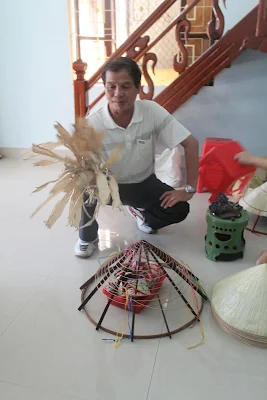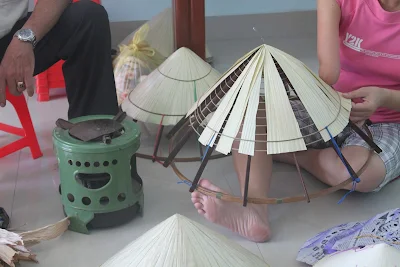Referred to as "non la" or literally, leaf hat, in Vietnamese, such cone shaped hats protect the wearer from the harsh sun of the tropics and equatorial areas - and are seen through out most of South and south-east Asia. Comparable versions are also found in Korea and Japan with temperate climes. With my travel mates, I had the opportunity to view how such hats were made in Hue in central Vietnam.
The natural young leaves are gathered, softened by dew, dried or flattened by ironing or processed further by heating them over a charcoal flame pot ( in picture on the right, the green item). This causes the leaves to transform into a light brown textured colour (photos below) before being placed on a conical frame. It is all hand made, a rarity in a world of fast turnover, manufactured processes and similar patterns and shapes. The quality of such hats are judged by the regularity of the leaf arrangement, the absence of visible knots and the roundness of the resulting rim.
Paper cut patterns are placed over the set leaves (photo above) in a near final stage of the handicraft demonstration. The leaves can vary in origin - they can be the bark of the Moc tree, bamboo or palm leaves. The paper cuts are unique in the making of the Non Bai Tho or the poem hat, which are unique to the previously royal city of Hue - and their specialty is based on poem lyric lines or pictures of things that can only be seen through sunlight under the leaf layered sunk designs. The significance of such conical hats is linked to the tradition of maternal love and the practice of padi growing in Vietnam. Interesting enough, women wore more broad-rimmed hats than men. I observe that the best cone shaped Vietnamese hats are made in Hue and no where else. There can be a practical difficulty in packing such hats in airline baggage unless they are miniature versions bought as souvenir displays.




















